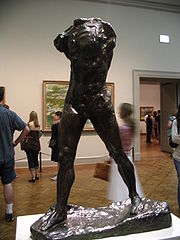
The Walking Man
Encyclopedia

Auguste Rodin
François-Auguste-René Rodin , known as Auguste Rodin , was a French sculptor. Although Rodin is generally considered the progenitor of modern sculpture, he did not set out to rebel against the past...
. The medium is bronze. It was created by Rodin during 1877 and 1878.
The best example of Rodin’s ‘sketchy’ impressionist sculpture also happens to be his most well-known ‘incomplete’ figure. This work personifies the latter part of Rodin’s career: the dynamic pose of a partial figure. Deriving much from Rodin’s earlier work St. John the Baptist Preaching, including the powerful stance, Rodin had stripped all academic associations from his figure, and instead focused on what he considered essential: the dynamic pose.
According to the Bibliography supplied by the National Gallery of Art
National Gallery of Art
The National Gallery of Art and its Sculpture Garden is a national art museum, located on the National Mall between 3rd and 9th Streets at Constitution Avenue NW, in Washington, DC...
, the Walking Man is a version St. John without head and arms. This sculpture was based on the movement of the piece. It was used to considered to be a preliminary study for the complete Baptist. According to Albert Elsen and Henry Moore's suggestions, the Walking Man was created for the purpose of a Roman or Greek art without the any live reference. Some people even believe that it has some connection to Hercules without a head or hands.
Noted art historian Leo Steinberg
Leo Steinberg
Leo Steinberg was an American art critic and art historian and a naturalized citizen of the U.S.-Life:Steinberg was born in Moscow, Russia and grew up in Berlin, Germany. He was the son of Isaac Nachman Steinberg. He studied at the Slade School of Fine Art...
said of The Walking Man’s pose:
The stance is profoundly unclassical, especially in the digging-in conveyed by the pigeon-toed stride and the rotation of the upper torso. Unlike the balanced, self-possessed classical posture with both feet turned out, Rodin uses the kind of step that brings all power to bear on the moment’s work
The statue has also served as the inspiration for the works of other artists, such as Carl Sandburg
Carl Sandburg
Carl Sandburg was an American writer and editor, best known for his poetry. He won three Pulitzer Prizes, two for his poetry and another for a biography of Abraham Lincoln. H. L. Mencken called Carl Sandburg "indubitably an American in every pulse-beat."-Biography:Sandburg was born in Galesburg,...
, who described it in his 1916 poem, "The Walking Man of Rodin":
THE WALKING MAN OF RODIN
Legs hold a torso away from the earth.
And a regular high poem of legs is here.
Powers of bone and cord raise a belly and lungs
Out of ooze and over the loam where eyes look and ears hear
And arms have a chance to hammer and shoot and run motors.
You make us
Proud of our legs, old man.
And you left off the head here,
The skull found always crumbling neighbor of the ankles.
External links
- Link to The Walking Man on the official website of the Musée Rodin.
- http://www.rodin-web.org/works/1878_baptist.htm BIBLIOGRAPHY (supplied by The National Gallery of Art, Washington)

